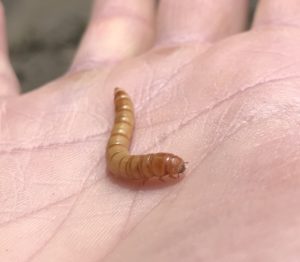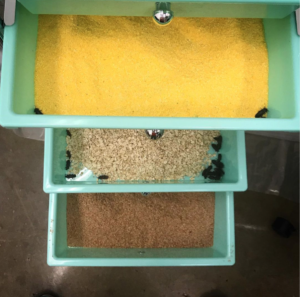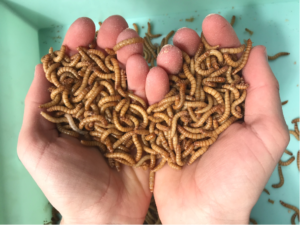Raising Insects: A Sustainable Protein Source & Emerging Market
Experimentation with small-scale mealworm-rearing and processing of insects into food products sheds light on new opportunities for the adventurous entrepreneur and farmer.
Entomophagy. Insect protein. Sustainable ‘meat.’
Producing invertebrates for human consumption is nothing new. Over 2 billion people around the world already eat insects as part of a regular diet, and the trend is extending its feelers into the United States.
My partner Jake and I first became interested in producing insects for human protein when a vegan friend of ours mentioned he would be willing to eat insects as a form of protein. We started reading articles about insects in the food industry and what farmers, factories, and labs were doing to innovate the science of eating insects. What we learned was surprising, exciting, and enough to get us looking deeper into the subject.

The humble mealworm
Haley Rylander / Cornell University
Insect production is much less resource intensive than the production of grain feed or livestock. Insects are more drought tolerant, require less space, produce fewer waste products, and can use low-quality feed or even convert industrial waste into a usable product. What’s even more surprising is the nutritional similarity between insects and livestock. The protein and nutrient content of insects is comparable to common livestock and can be a great way to introduce protein to areas where livestock meat and milk or milk powder aren’t readily available.
One of the best things about insect production is that it can be done on a backyard scale as readily as industry-level. This is what sparked the idea of our project. We decided to delve deeper into insect production on a small scale that could be conceivably incorporated into small farms or homesteads. Commercially, the most produced insects are crickets, but we chose to work with the runner-up of the title — mealworms — for their adaptability to smaller and quieter spaces.
We decided to design a mealworm-rearing system and to find ways to make insect consumption in the U.S. a more realistic possibility. As it stands, most insect consumption in America is in the form of novelty — flavored snack packets of fried or chocolate-covered crickets, sugary protein bars, or powders used to make baked goods like brownies or cookies. These all have their place in changing public perception of eating insects, but we wanted to experiment with recipes that could actually provide nutrition and calories to people in a healthy way, namely, pasta and crackers.

Substrate/feed trials: cornmeal, oats, and wheat bran
Haley Rylander / Cornell University
We raised mealworms in stacked-drawer systems from Michael’s craft store and assessed different substrate/feed options: wheat bran, oats, and cornmeal. We fed the mealworms slices of raw potato each week for moisture and nutrients and raised the insects through three full life-cycles, harvesting batches of mealworms with each cycle and experimenting with food processing options for small-scale businesses.
Wheat bran is the most commonly used mealworms substrate, and in our experiment, it definitely produced superior yields to oats or cornmeal. Still, we were concerned about possible gluten contamination in the finished product, which would exclude a portion of the population from eating the mealworms. This led us to perform gluten tests on mealworms from each substrate. The wheat-raised mealworms did, indeed, contain gluten, though concentrations were reduced if the mealworms were purged of food one week prior to harvest. Oats and cornmeal were safely gluten-free, but they produced small and inconsistent mealworm yields. Finding an alternative substrate for gluten-free mealworms could prove a challenge.
We processed the mealworms by freezing and blanching them, then drying them in a food dehydrator, followed by a brief oven heat-treatment for further sanitation. We milled the dried worms in a Kitchen Aid flour mill and used the ‘mealworm flour’ to make protein-enriched pasta and crackers. Both turned out well with a 25% mealworm to flour ratio, though the crackers held together better with oil as a binding agent. Mealworms have a nutty, almost cheesy flavor that pairs well with bread-like products!
Along with the experiment, we organized a survey of 500 people to gage consumer reactions to insect-based protein products. Reactions varied widely, with 30% of responders completely disgusted by the idea and only 8% thrilled by it. Most people fell in between, saying they would be willing to try insects or would be more amenable to the idea if they could not see the insects in the product they consumed. When asked what form they would be most willing to eat insects in, the most popular choice was as a tasteless or flavored powder able to be added to smoothies, protein bars, or cooking.
Normalizing the idea of insect consumption for people is the biggest hurdle to overcome when it comes to increasing insect production as a protein source. For every farmer who adopts this practice, even on a very small scale, more consumers are able to see that insect consumption can be an efficient, sustainable, and even tasty part of the food system.

A handful of worms at harvest
Haley Rylander / Cornell University
If you’re still not convinced of using insects as a human food source, there are tons of other ways insects can improve the global food system, or even just come into use on a farm.
Animal feed is one of the most expensive aspects of livestock production, and the most damaging to the environment. Insects make an excellent protein source for livestock feed, especially for fisheries, where it can help replace soy (deforestation, pollution, water-use) and fishmeal (overfishing). Insects also make tasty treats for chickens!
Whatever use the insects themselves go to, their waste — frass — is an excellent fertilizer for crops.
Want to learn more?
There are tons of resources online for raising insects for food. Two of the most comprehensive include:
Edible Insects: Future prospects for food and feed security (FAO)
http://www.fao.org/3/i3253e/i3253e.pdf
Insects as sustainable food ingredients: Production, Processing, and Food Applications (Dossey et al.)
https://www.amazon.com/Insects-Sustainable-Food-Ingredients-Applications/dp/0128028564
For more pictures and information, go to @invertfarms on Instagram.
Haley Rylander is an extension specialist with the Greenhouse Lighting and Systems Engineering (GLASE) consortium and worked for years doing research in small-scale vegetable farming. Jake Holly is about to finish his Ph.D. from Cornell in horticulture, specializing in greenhouse lighting and leafy green production in controlled environment agriculture.

